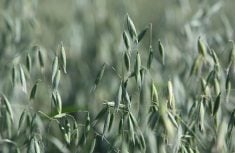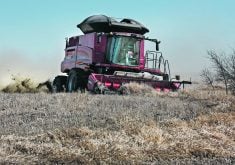Check before you dry
Farmers drying grain this year can save time and frustration by doing some simple checks before dumping that first load into the bin.
The advice comes from experience, says the Prairie Agricultural Machinery Institute.
While evaluating bins in the spring of 1989, Wayne Stock recalled the rate of drying came to a halt during the second week of operation.
“It wasn’t until we performed static pressure measurements in the bin versus the fan that we found the problem.”
Read Also

VIDEO: Green Lightning and Nytro Ag win sustainability innovation award
Nytro Ag Corp and Green Lightning recieved an innovation award at Ag in Motion 2025 for the Green Lightning Nitrogen Machine, which converts atmospheric nitrogen into a plant-usable form.
The aeration screens were completely plugged with poplar fluff sucked in by the fan during spring drying, virtually eliminating air flow through the bin.
The problem could easily be overlooked by anyone who has done some spring drying.
Depending on the area, fan location on the bin and in the yard, any airborne foreign material near the fan can go in and plug the natural air dryer (NAD) screens quickly.
“We had to empty the bins and wash the screens to get everything functioning normally again. That’s the kind of hassle no farmer needs at harvest time.”
While not many farmers have the ability to perform static pressure tests in their bins, there are some basic steps to prevent the problem.
- Check the static pressure of the fan with a manometer, a simple device you can build yourself, used to measure airflow.
Checking the pressure every couple of days will show any sudden increases in pressure due to plugging of screens.
Static pressure may be higher at the end of drying due to shrinking of the grain kernel.
- Use the hat method. This may seem a bit crude, but if the fan won’t hold a hat against the inlet guard, there is a problem with airflow.
- Check and clean NAD screens prior to fall harvest, especially if any spring drying was done.
- Check fan blades prior to operating. A build-up of material on the blades can throw them out of balance, putting extra stress on bearings.
- If spring drying was necessary in an area with poplar fluff, build a fan inlet filter consisting of six-inch cement mesh wire, covered with window screen, rolled the same diameter as the fan and attached to form a one-foot deep cylinder.
This keeps the inlet of the fan exposed and won’t hamper performance.
For details on how to build and use a manometer, call the Report Request Line 1-800-567-PAMI and ask for PAMI Notes GD8.
– PAMI
Moisture lessens pulse damage
A recent Alberta Agriculture project has yielded some interesting results for pulse crop producers looking for ways to lessen impact damage.
Pulse crops are fragile. During every stage, from harvesting and cleaning to storage and transportation, the seeds experience free falls.
The falls range from a few feet on the farm to over 30 metres in grain terminals. Each fall can mean a quality loss.
“We investigated the extent and causes of damage from free fall,” said processing engineer Kris Chawla. Researchers used drop heights of 4.3 , 7.4 and 16.6 m.
Express peas and small red beans were dropped onto three surfaces – concrete, metal and seeds-on-seeds.
Seed moisture was adjusted to three different levels; 11.13 percent, 15.39 percent and 21.38 percent. The pea moisture levels were 12.81 percent, 16.86 percent and 20.48 percent. The tests were conducted at temperatures of 22¡C and -15¡C.
Results suggest damage is less at warmer temperatures, from lower heights, when seeds are dropped onto seeds and when moisture level is higher.
“In both beans and peas, the total damage decreased significantly as the moisture level increased,” Chawla said.The effect was more pronounced in beans.
Drop height was a significant factor in physical damage as well. The higher the drop height, the more damage occurred. Damage was less when the seeds were dropped on each other than when they were dropped on concrete or steel.
Temperature was also a factor, especially with peas, when cold weather damage was 3.5 times worse than the damage caused at room temperature.
– Alberta Agriculture
















